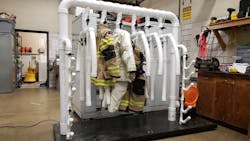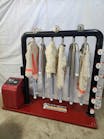OH Firefighters Devise PPE Drying Solution
By Richard Wilson
Source Dayton Daily News, Ohio
As state and federal officials make changes to raise awareness and protect firefighters from job-related risks of cancer, Xenia firefighters are getting national attention for a new method of drying gear quickly without dipping deeply into public funds.
After news spread of the apparatus Xenia firefighters built to dry their gear quickly, departments from Maine, Texas and other states have contacted Xenia Fire Capt. Jeff Bruggeman about the project.
“The mandate now is that we wash our gear after every single fire. That’s due to cancer initiatives,” Bruggeman said.
Fire departments are implementing national guidelines to keep gear clean and free of carcinogenic materials that are released during fires.
At the Xenia station on East Main Street, fire gear is prohibited from being worn into office spaces and training rooms.
Last year, Ohio lawmakers extended workers compensation for firefighters to include treatment of cancer. This past summer, President Donald Trump signed a law that requires the Center for Disease Control and Prevention to develop and maintain a voluntary registry of firefighters with cancer.
The Firefighter Cancer Registry Act calls for a collection of career professionals or volunteers to provide information such as number of years on the job, number of calls responded to, and incident type.
Bruggeman said the problem isn’t washing the gear. Drying the heavy material that protects men and women from heat and flames is a challenge. Bruggeman said a normal dryer will degrade the gear’s material over time, and for years air drying was the only option.
A clothes-line stretched across the bay inside the fire station on East Main Street was the old way to air dry the washed gear. That and whatever railing was available.
“It would take up to two to three days to dry completely to put it back in service,” Bruggeman said. “Not everybody has two sets of gear, so we were running into an issue with turnaround, so we couldn’t wash our gear like we were supposed to.”
The apparatus that Bruggeman and other Xenia crew members made consists of PVC pipe, flexible hosing and a blower that would be used for a bounce house. He estimated the total cost was $1,100 in materials and 36 hours of work.
Bruggeman said similar units are available to buy commercially. They can cost up to $12,000 depending on the features.
———
©2019 the Dayton Daily News (Dayton, Ohio)
Visit the Dayton Daily News (Dayton, Ohio) at www.daytondailynews.com
Distributed by Tribune Content Agency, LLC.






